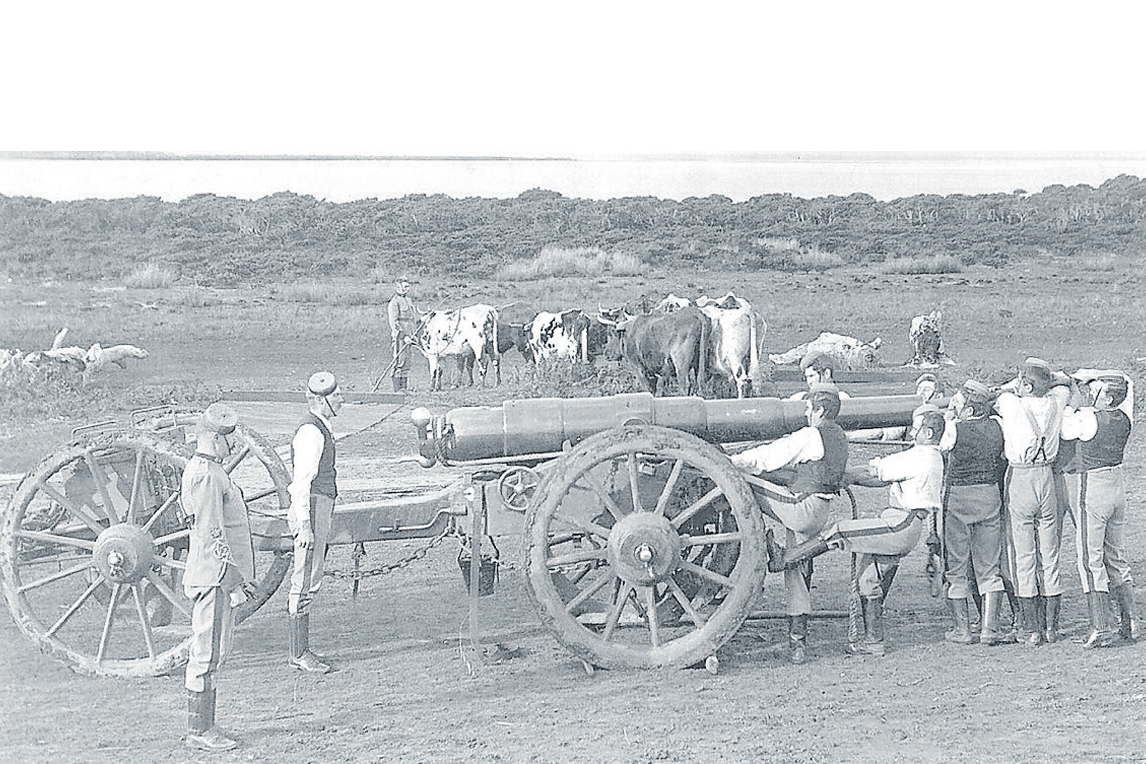
A drill on the Hastings Foreshore with one of the forty pounders.
By Peter McCullough
LONG before the extensive and frightening casualty lists monopolized the Melbourne papers in the years 1914 – 1918, there were occasional casualties which occurred in a training context. The town of Hastings was saddened by two of these. Both occurred long before the Gallipoli landings and both were the consequences of the perceived threat of invasion of the Mornington Peninsula.
The Hastings Battery
The threat of invasion by the Russians and/or French, whether real or imaginary, sparked a flurry of activity in various parts of the Peninsula in the 1880’s. Tensions rose when a Russian trawler paid a visit to Western Port. Accordingly, on 15 December 1889, a resolution was passed at the conclusion of a meeting of the Fishermen’s Union in Hastings, calling for the formation of a Hastings Battery.
In July 1890 the Governor–in–Council approved of the formation of a Victorian Rangers Battery at Hastings. With Lieutenant David Ham in charge and four Armstrong 40–pounder rifled breech–loading guns that were moved by bullocks, the locals gave it the name of the “Ham and Beef Battery.”
In 1904 the Hastings Battery transferred from the Victorian Rangers and became known as the 6th Battery of the Australian Field Artillery. The forty pounder breech–loading guns were replaced with twelve–and–a–half–pounders, to be converted to fifteen pounders.
Francis Incigneri
NOT as well known as the death of Trooper Benton which occurred some 12 years later, was the death of Francis Incigneri which occurred in the grounds of Hastings State School in 1893.
In April 1882 Josiah Ingamells assumed his responsibilities as Head Teacher at Hastings State School. He was the second person to fill this role, succeeding John Bettesworth Flemyng (1872-1882). Both men were “builders”, held in high esteem by their staff and the community at large. Taking a cue from the establishment of the Hastings Battery, Ingamells formed a school cadet unit under Captain Henry. These cadets were involved in camps and drills, both in school hours and after school, and on Friday nights from 7pm to 8.30pm. Older boys had rifle practice, and the ability to handle a gun was greatly valued in the colony at that time.
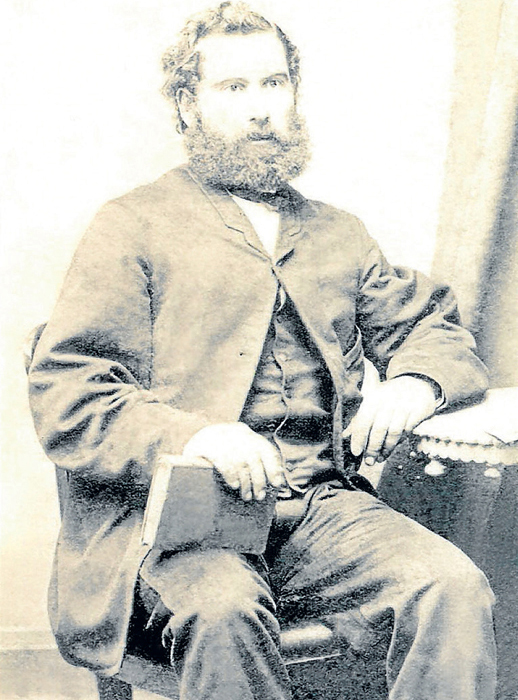
Giuseppe Incigneri.
Among the many Italians who came to Hastings as fishermen in the second half of the nineteenth century was Giuseppe Incigneri. Born in Catania, Sicily, in 1838, he jumped ship at Queenscliffe in 1856, lived there for some years as a fisherman, and then came to Hastings where he purchased land in 1866. Giuseppi’s first wife, Annette Wells, who he married in 1866, died three years later without having children. He remarried, to Annie Larkin, in October 1871 and they had ten children, extending from Mary Santa (born 1872) to Matthew Joseph (born 1891). One of the girls, Antoinette (born 1889), lived only two months with the cause of death recorded as “suffocation”; what would be called “cot death” in more recent times.
In her short family history “To Have a Little House” Angela Incigneri details the death of Giuseppi and Annie’s third son, Francis, who was born in 1880:
“Young Francis was as enthusiastic a cadet as he could be. Among his friends in the unit were Frederick Cussworth, Frederick Perrott, James Mentiplay and William Thornhill. Although he had left school, Joseph was also a cadet and had made the rank of Sergeant. On 25th August, 1893, twelve of the cadets, including Francis and Joseph, were with their teacher at rifle practice in the schoolyard. They fired first at a distance of 100 yards and then started to move back to the 150 yard mark,while Thornhill tried a last time at 100 yards. Cussworth, Perrott, and young Francis were the “markers” who checked the results of the shots, and all three moved in to see if Thornhill had hit the target. They were standing in front of the target when James Mentiplay shot from 150 yards. In the confusion and trauma afterwards no one was quite sure why James had shot but, as Francis turned to give the results of Thornhill’s shot, he was hit in the neck. Cussworth reached to support him and take him to get help, and together they walked about ten paces. Francis whispered “Scotty, leave me go” and dropped to the ground dead.
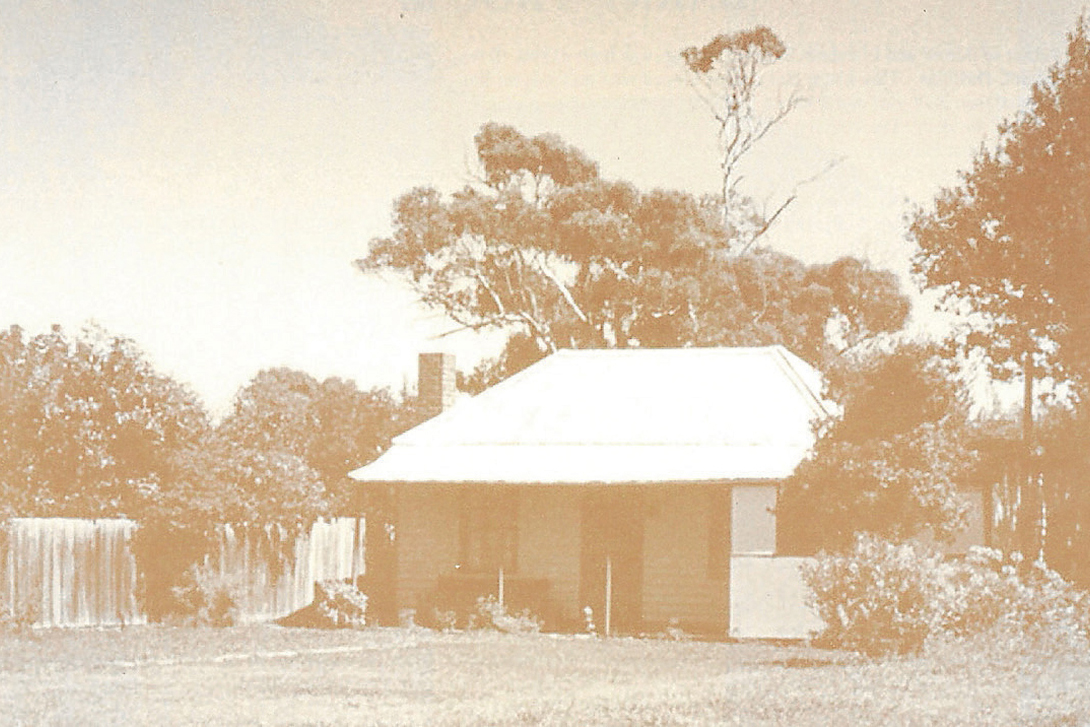
The Incigneri home in Victoria Street, Hastings, demolished in 1977.
Someone ran to tell his parents, and the body was carried back to the house. This death of a second child hit the family hard. Giuseppi was still too shocked to speak more than a few words at the inquest the next day. Coming just three years after Antoinette’s death and concurrent with the financial problems which were gripping the country, Francis’ death had a deep effect on the family. Gradually, life resumed but Giuseppi was reputedly never the same again.”
(In fact Giuseppi Incigneri died at the age of 58 on 11 August, 1896.)
On the following Monday, August 28, 1893, The Argus carried a report on the magisterial enquiry into the tragedy:
“Mr. D. J. Ham JP held a magisterial enquiry at Hastings on Saturday on the body of cadet Francis Incigneri who was shot during rifle practice on Friday by another cadet named James Mentiplay. The evidence showed that the deceased who, with three others, was acting as marker, was in front of the target taking a score when Mentiplay fired the fatal shot. Mentiplay gave evidence, and although his statement was very conflicting, he was emphatic that he did not see anyone near the target when he fired.
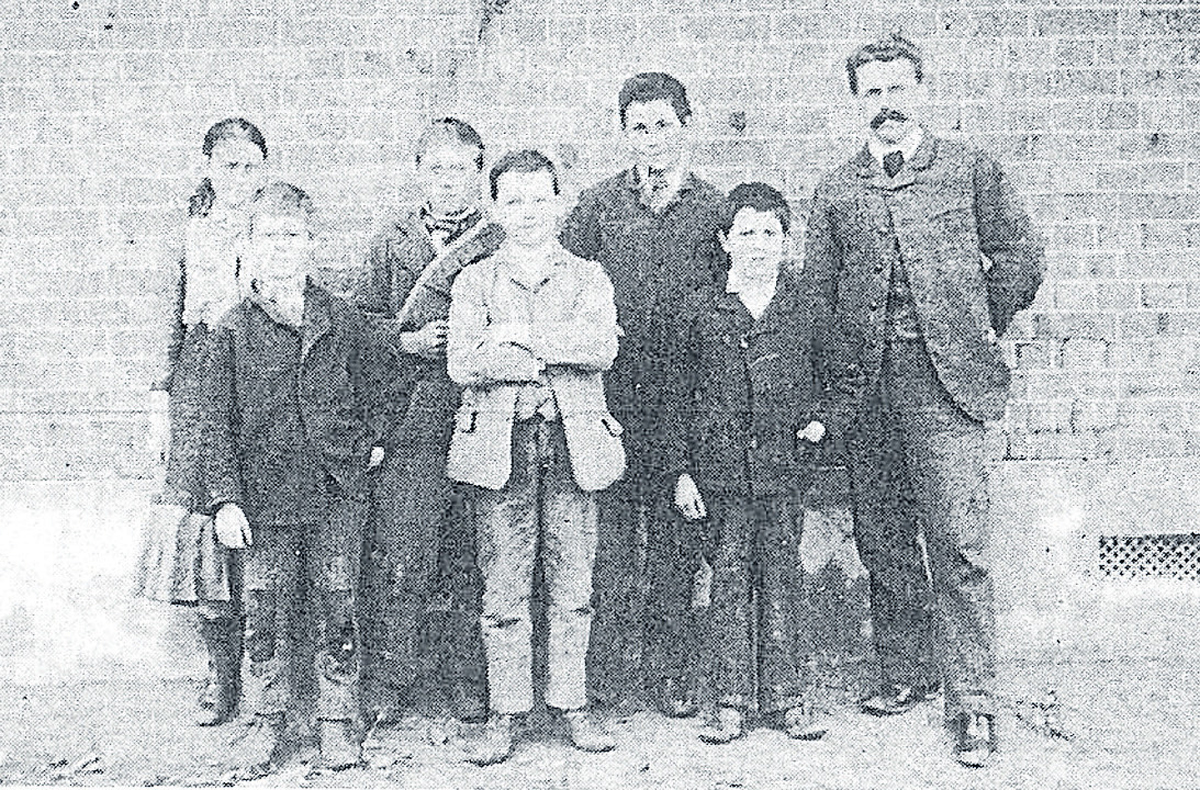
Mr Ingamells with some of his Hastings pupils in 1882.
Mr. Ham recorded a verdict of accidental death, and added a rider that the system of allowing boys of tender age to carry and use deadly weapons was one which required amending.
Major Henry subsequently held a military enquiry into the accident, and had forwarded his report to the commandant.
Cadet Incigneri was accorded a military funeral yesterday.” – The Argus, Monday, August 28, 1893.
Giuseppi provided an affidavit to the enquiry, (pictured).

The affidavit provided by Giuseppe to the Magesterial Inquiry.
The 1890’s had been difficult for Head Teacher Josiah Ingamells: Hastings had been hit hard by the Depression and pupil enrolments had declined leading to a reduction in his pay. However the accident in the school ground near the creek was “the final straw.” Although the magisterial enquiry absolved him of all blame, Mr. Ingamells wrote, “…the onus of the accident is almost more that I can bear.” In September his health failed, and he sought a month of leave. Early next year he successfully applied for a transfer to Ballarat East State School, departing Hastings on 21 March, 1894.
In the period following the death of the young cadet, a teacher (Miss Hollier) drew a memoriam consisting of a “framed card” which was displayed in the school. The spot in the school ground where the boy died was also commemorated for many years in the form of a small garden plot. Sadly, a search at the school has failed to find any trace of the “framed card” and the memorial garden has long since disappeared.
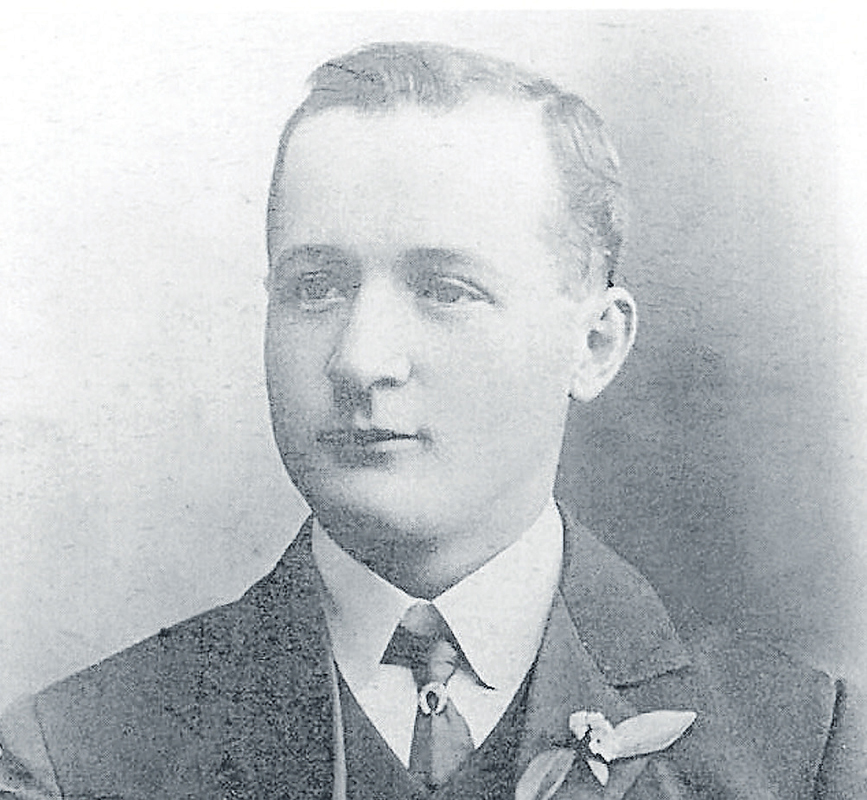
Gunner E. K. Benton.
Gunner E. K. Benton
Some 12 years after the State School tragedy came the death of 19–year–old Ernest Kempster Benton. The Hastings Battery had become an important part of the community, and many men had volunteered to man it. This included the three Benton boys (Arthur, Ernest, and Albert) who were enthusiastic members. The Mornington Standard of 29 April, 1905 conveyed the news of the tragic death of Ernest:
“The Easter encampment in Bittern in 1905 was marred by a tragic mishap on Monday afternoon. Everything in connection with the breaking up of the camp went well, as far as the main body of the brigade was aware, until the Hastings station was reached, at about 10 minutes past 3. Here was found a squad of men belonging to the Hastings Half–Battery, which had gone home by road. Lying on a stretcher they had with them Gunner E. K. Benton, son of Mr. G. Benton of Hastings, who had some 20 minutes before met with a horrible accident. At the Hastings gun shed when the Half-Battery got back, an employee of the contractor who had lent horses for the encampment had tied one of the animals to a guy–rope supporting the flagstaff. Gunner Benton went to release the horse, which drew back. As a result of the strain on the guy–rope, the pole came down, and struck the unfortunate soldier with great force on the top of the head. The services of a local doctor were not procurable, so it was decided to carry Benton, who was unconscious, across to the station to await the arrival of the last Artillery train, on which Surgeon–Major Cuscaden was known to be a passenger.
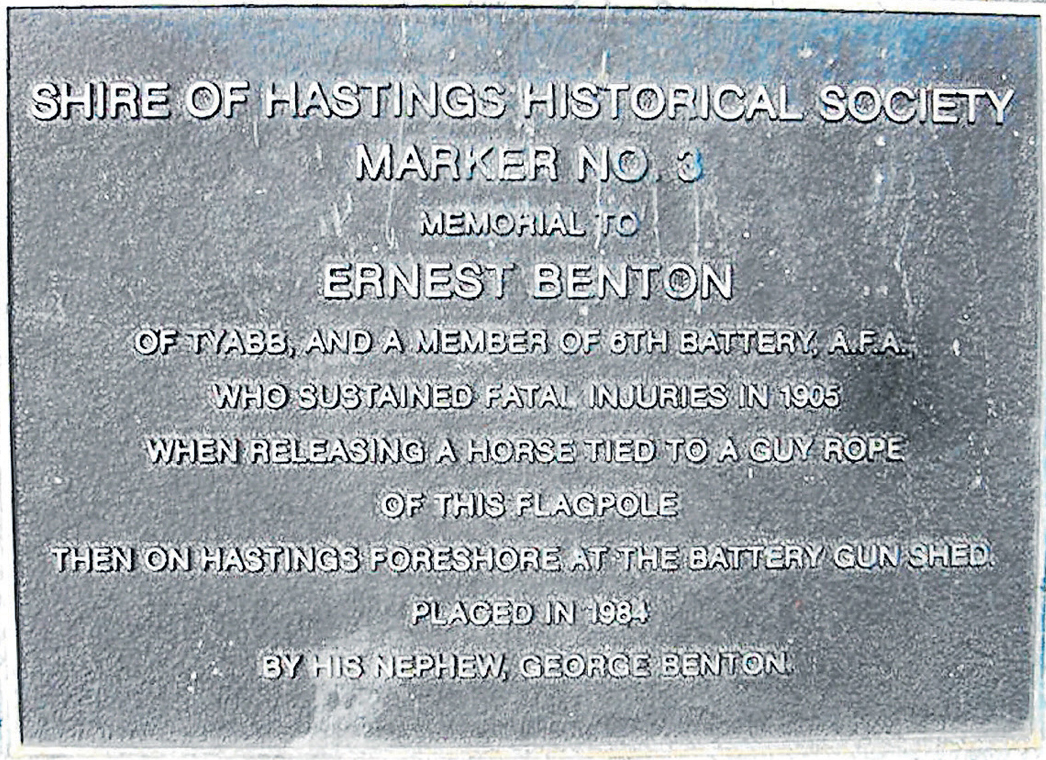
The plaque at the Tyabb Memorial referring to the original flagpole.
As soon as the train arrived Major Cuscaden examined the sufferer, and to the sorrow of all around, expressed the opinion that Benton would not live long. Major Cuscaden considered that it would be the most humane course to have the patient put into the train and brought to the Melbourne Hospital, although it was not likely that he would live to the end of the journey of about two and a half hours’ duration. He survived the journey, but died at half past 6pm from a depressed fracture of the skull.
The funeral took place at Hastings with full military honours. The coffin, which was brought to Melbourne by train, was wrapped in the folds of the Union Jack, and placed on a platform mounted on one of the 15–pound guns. At 10.30am the cortege started from the railway station, headed by a firing party from No. 6 Battery, marching with reversed arms. The gun bearing the coffin followed, the horses and harness being draped with black and white ribbons and rosettes. The pallbearers marched on either side of the gun. A vast concourse of vehicles and horsemen, from all parts of the peninsula, brought up the rear.”
The flagpole which was responsible for the death of Gunner Benton was retained and in due course was erected in the war memorial precinct in Tyabb. A plaque explaining its significance was placed alongside the flagpole in 1984. Last year the Mornington Council decided to embark on a tidying up exercise in the war memorial area. To the dismay of members of the Benton family, the historic flagpole was replaced by a metal version. And so the plaque now commemorates a flagpole which, presumably, resides in the bowels of the McKirdys Road tip!
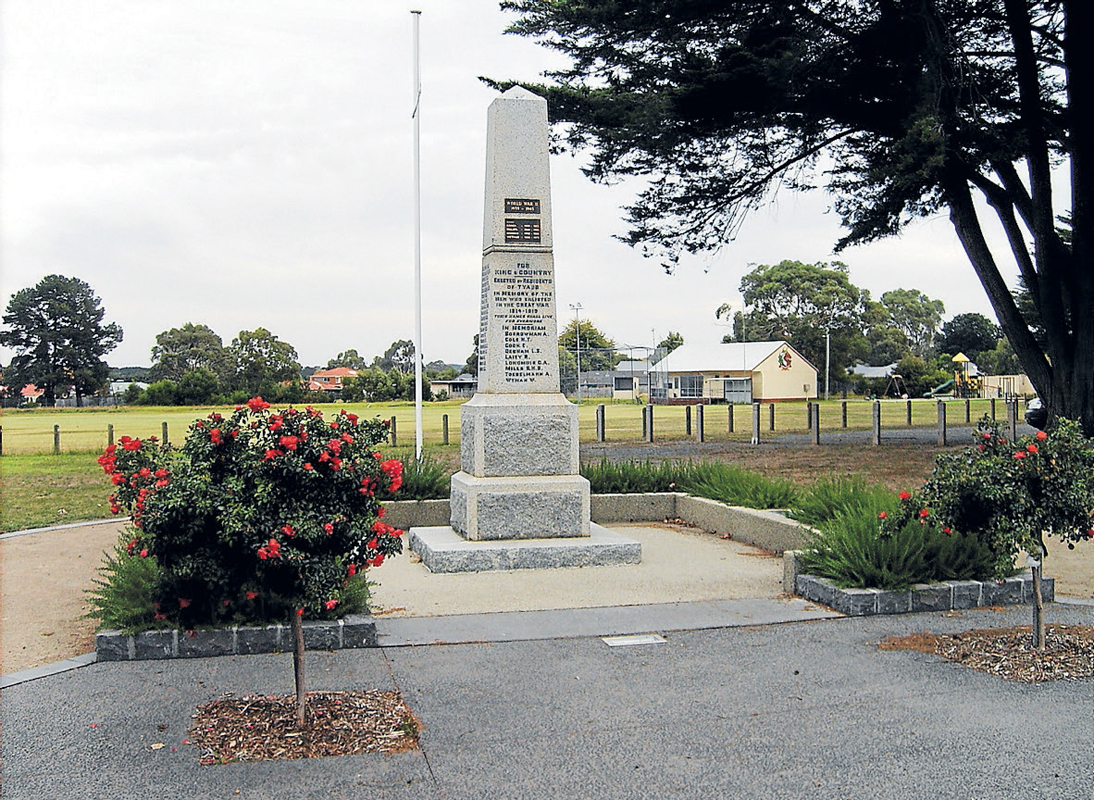
The Tyabb Memorial with the new metal flagpole.
References:
“Hastings People and Places”, Vol 1 Hastings-Western Port Hist. Society Inc. 2004
“To Have a Little House”, Angela Incigneri. 2000
“The History of Hastings Primary School”, Hastings Primary School Council. 1981





